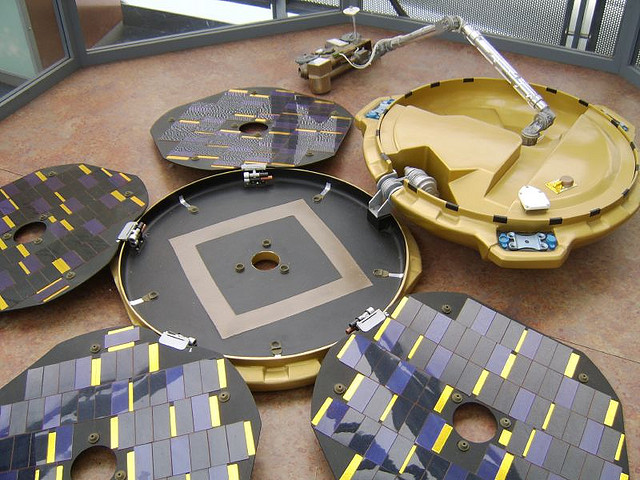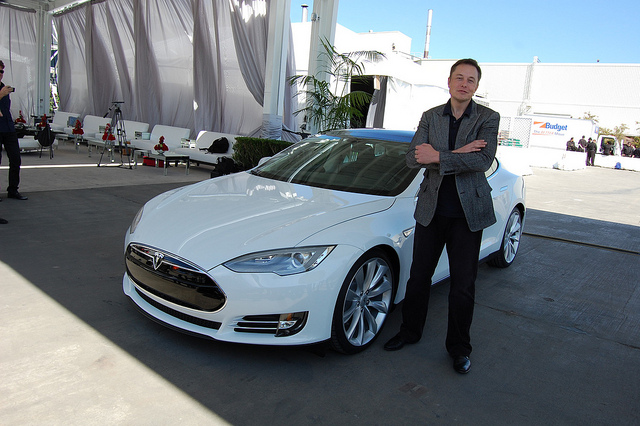
The Beagle Has Landed
This is a photo of a model of the Beagle 2, a British lander that was part of the Mars Express mission in 2003. This, we think, is a picture of it, too:

In December of 2003, ESA lost contact with the lander, which was supposed to have sent back a confirmation that it had made it to the surface. The call home never came, and for over a decade we’ve been wondering what went wrong. Now it appears as though it’s been found by HiRISE, a camera on NASA’s Mars Reconnaissance Orbiter. From what we can tell, it landed just fine, but for some reason its solar panels didn’t unfurl properly, preventing it from booting up and calling home. In theory, if you happened to be walking by and folded them open yourself, it could begin its mission (though if you could do that, the mission wouldn’t be terribly necessary anymore). Maybe Elon Musk will go pick it up someday. Check out the Guardian or Emily Lakdawalla’s post over at the Planetary Society for more on the story.
Elon Musk

Speaking of the billionaire founder of SpaceX and Tesla (among other things), he’s been in the news a lot this week, mostly because he says the most wonderful things. All in one day, he told the world he’s going to build a five-mile test track to prove his Hyperloop concept, he announced plans to build a Space Internet, and he tweeted a vine of the “rapid unscheduled disassembly” of the first stage landing attempt.
The Hyperloop test track will probably be in Texas, and will do some of the innovative heavy lifting so other teams don’t have to. The “Space Internet” is going to consist of hundreds of satellites orbiting only about 750 miles up, which is a lot closer than your typical communications satellite, which sit above 22,000 miles up in geostationary “Clarke belt” orbits (check out Businessweek for more on that). And because you wanted to watch it over and over, here’s the vine of the “disassembly” for your viewing pleasure.
Google News

There are three pieces of interesting news this week out of the company that once upon a time was just a lowly search engine. First, at its Project Ara developers conference this week, Google announced that its modularized cell phones will be tested “in the wild” in Puerto Rico this year. According to TechCrunch, there are currently 11 functioning modules available, and the battery life isn’t great yet, but they’re hoping to have around 30, and get battery up to industry standards, by the end of the year. Next, Google updated its Translate app this week to have two new features: instant, real-time voice translations, and something called Word Lens. The real-time voice translations are very cool, but for me it’s all about Word Lens. Basically, you hold up your phone and point it at text in a language you can’t read, and the image on your phone shows it to you in your language. Right now it only works to and from English, and only with German, French, Spanish, Russian, Italian, and Portuguese, but Google promises more to come. Star Trek’s universal translator is right around the corner. Finally, Google announced this week it was ending sales of its Google Glass headwear — but only for now. Glass is being moved out of the experimental products department Google X and over into the consumer electronics part of the company (the team will be reporting to Tony Fadell, CEO of Nest). Expect more versions of the wearable internet in the future.
Robust and Beneficial
Those who know me know that I find warnings that artificial intelligence could put an end to the human race a little amusing, at least where we are now technologically. But both Steven Hawking and Elon Musk think it’s a real threat. So it’s interesting to note that both have now signed an open letter put forth by the Future of Life Institute, “a volunteer-run research and outreach organization working to mitigate existential risks facing humanity… currently focusing on potential risks from the development of human-level artificial intelligence.” The open letter, with hundreds of signatories, recommends “expanded research aimed at ensuring that increasingly capable AI systems are robust and beneficial: our AI systems must do what we want them to do.” To top it off, Musk has also donated ten million dollars to the organization, to stimulate research into keeping AI “beneficial” for humanity as we develop it. Well, it’s better safe than sorry, I guess.
Right to Spy
Finally, at the bottom of the news for this week, UK prime minister David Cameron has pledged to put an end to online privacy, saying that there should be no communication that cannot be read by agents of the government or law enforcement with an appropriate warrant. That is, he’s pledged to rid the UK of the scourge of end-to-end encryption. This is as catastrophically stupid as it is ideologically bent. Cory Doctorow, writing over at boingboing.net, has described it as a proposal that “would endanger every Briton and destroy the IT industry.” I have very little to add, so I’ll just link to his piece. Go read it if you have the time.
That’s all for today, folks. Have a great week.
